
Mr. Handyman explains vinyl flooring and its key differences from laminate and hardwood.
|
Choosing between laminate and vinyl flooring sounds easy — until you’re staring at a wall of samples, wondering which one won’t buckle under the weight of your daily life.
While vinyl and laminate flooring options may look alike, they behave very differently. Picking the wrong material for your space, especially in high-moisture and high-traffic areas, could mean replacing it far sooner than you’d like.
Whether you’re DIY-ing or hiring a pro, knowing your options is essential for a successful flooring project. This guide breaks down the choice of laminate vs vinyl flooring, including key differences that can help you make a decision that fits your style, budget, and lifestyle.
What Is Vinyl Flooring?
Vinyl flooring is a synthetic, budget-friendly flooring option designed to mimic the look of wood or stone without the high price tag or maintenance. It’s made from layers of plastic (typically PVC) that provide water resistance, durability, and flexibility.
Vinyl is a popular pick for areas that see water, mess, or lots of foot traffic, like kitchens, bathrooms, mudrooms, and basements. It’s also DIY-friendly, with click-lock or peel-and-stick installation options.
There are a few types of vinyl flooring:
- Luxury Vinyl Plank (LVP): Looks like wood, installs like laminate.
- Luxury Vinyl Tile (LVT): Mimics stone or ceramic tile.
- Sheet Vinyl: Large, continuous sheets, great for bathrooms and kitchens.

What Is Laminate Flooring?
Laminate flooring is a multi-layered synthetic product that mimics the appearance of real wood, but underneath that beautiful surface is a high-density fiberboard (HDF) core made mostly of wood byproducts.
Each plank typically includes:
- A wear layer that protects against scratches and fading
- A photographic layer that provides a realistic wood or stone look
- A core layer made from pressed wood fibers
- A backing layer for stability and moisture resistance
While laminate isn’t waterproof like vinyl, it’s still a solid choice for dry areas like living rooms, bedrooms, or hallways. It’s easy to clean, fairly durable, and often comes with click-lock systems for hassle-free DIY installation.

Laminate vs Vinyl Flooring: What’s the Difference?
Laminate and vinyl flooring may look alike on the surface, but underneath, they’re built differently — and those differences matter.
Here are the key comparisons between laminate and vinyl flooring:
| Vinyl | Laminate | |
|---|---|---|
| Materials | Vinyl flooring is made entirely from synthetic materials, typically PVC, making it water-resistant or waterproof. | Laminate has a wood-based core (HDF), which makes it more vulnerable to moisture. |
| Water Resistance | Vinyl is preferred for high-moisture areas like bathrooms and basements. | Laminate can resist light spills but may be susceptible to damage from standing water. |
| Installation | Floating floor system with click-lock planks. Vinyl is easier to trim and shape for tricky spots. May be available in peel-and-stick or sheet formats. | Floating floor system with click-lock planks. |
| Durability | Vinyl stands up well to water, dents, and pets. | Laminate is tough against scratches and wear but doesn’t hold up well to water exposure. |
| Look & Feel | Vinyl can feel cooler and thinner, especially in sheet form. | Laminate has a more realistic wood feel underfoot, thanks to its thicker core. |
| Cost | Both are affordable, but vinyl offers more variety at lower prices. | High-end laminates can be pricier but often come with more realistic finishes. |
Laminate vs Vinyl Flooring: Pros and Cons
Still unsure which option suits your space? We’ll break down the positives and downsides of vinyl and laminate to help you make the best call. If you’re torn, considering the pros and cons of laminate vs vinyl flooring can make or break your decision depending on your space, lifestyle, and long-term plans.
Let’s break it down:
Vinyl Flooring Pros
- Water-resistant or waterproof — ideal for bathrooms, kitchens, and basements
- Affordable and easy to install (DIY-friendly)
- Durable under heavy foot traffic, pets, and daily wear
- Easy to clean and maintain
- Comes in realistic wood- and stone-look designs
Vinyl Flooring Cons
- May release VOCs (check product labels)
- Difficult to repair if damaged
- Doesn’t add much resale value
- May not feel as authentic underfoot as real wood
Laminate Flooring Pros
- Looks like real hardwood or stone
- Scratch- and fade-resistant — great for active households
- Budget-friendly alternative to wood flooring
- Easy to clean and maintain
- Softer and warmer than tile or vinyl
Laminate Flooring Cons
- Not waterproof — can swell or warp with moisture
- Not ideal for bathrooms or damp areas
- May require underlayment for soundproofing
- Less forgiving during installation
Laminate vs Vinyl Flooring: How to Choose the Right Option for Your Home
Choosing between laminate and vinyl flooring comes down to understanding your space, your lifestyle, and your priorities. Here’s a simple guide to help you decide:
Consider Moisture Levels
If you're flooring a bathroom, laundry room, kitchen, or basement, vinyl flooring is your best bet. Its water-resistant (and often waterproof) layers handle humidity and spills with ease. Laminate, on the other hand, doesn’t fare well with prolonged moisture exposure and may swell or warp if water seeps into the core.
Think About Durability Needs
Got kids, pets, or lots of foot traffic? Both options are tough, but vinyl takes the edge for scratch resistance and impact durability. Laminate flooring still performs well in dry areas and can last for years, but it’s slightly more prone to dings and scratches, depending on the quality.
Decide on Installation Type
If you’re DIY-ing, both laminate and vinyl offer user-friendly click-lock or peel-and-stick options. However, vinyl is more forgiving when it comes to uneven subfloors and tight spaces, especially if you're using sheet vinyl.
Think Long-Term Style & Feel
Laminate often offers a more realistic wood feel underfoot thanks to its thicker core and embossed textures. If you love the look and feel of hardwood (but not the cost), laminate might win your vote.
Budget Wisely
Vinyl typically starts at a lower price point and has fewer long-term maintenance requirements. Laminate flooring can cost a little more upfront, but it offers great value in dry living spaces.
Still unsure which material to pick? Check out our flooring tips and ideas for expert insights on materials, room types, and layout tricks that can help you decide
Laminate vs Vinyl Flooring: DIY or Expert Installation?
Choosing between laminate vs vinyl flooring is one thing — installing it is another. Both flooring types are considered DIY-friendly thanks to modern locking systems and pre-cut planks, but there’s more to a perfect installation than just snapping boards together.
Keep these considerations in mind:
- Go DIY if you’re confident with tools, your subfloor is even, and the space is small or square (like a bedroom or hallway).
- Call in a pro if the room has curves, cuts, transitions, or water exposure — especially bathrooms, kitchens, and basements. Mistakes here can lead to warping, lifting, or even mold over time.

Need Help Installing New Floors? Call Mr. Handyman
Still torn between laminate vs vinyl flooring? You don’t have to decide alone. Whether you want help picking the best material or need professional floor installation to save yourself the time and labor of laying flooring, your local Mr. Handyman team is here to help. We’ll treat your home with respect and get the job done right the first time.
Request service online or find your local Mr. Handyman to get started.
This article is intended for general informational purposes only and may not be applicable to every situation. You are responsible for determining the proper course of action for your home and property. Mr. Handyman is not responsible for any damages that occur as a result of this blog content or your actions. For the most accurate guidance, contact your local Mr. Handyman location for a comprehensive, on-site assessment.
FAQs About Laminate vs Vinyl Flooring
Mr. Handyman has been helping homeowners and businesses repair, maintain, and enhance their spaces for over 25 years! We are the one-stop solution for everything on your to-do list. This includes answering your questions about home repairs, maintenance, and improvements. Here are answers to some of your most frequently asked questions on laminate vs vinyl flooring.
What is the difference between laminate vs vinyl flooring?
The key differences between laminate vs vinyl flooring are water resistance and core material. Vinyl is fully waterproof and made of plastic, while laminate has a wood core and is water-resistant, not waterproof. Generally speaking, this makes vinyl a better option for wet areas like bathrooms or basements, while laminate can provide a more realistic look and feel for dry rooms.
What are the vinyl vs laminate flooring pros and cons?
Here’s a quick breakdown of the pros and cons of vinyl vs laminate flooring:
Vinyl Flooring Pros
- Fully waterproof
- Great for high-moisture areas
- Easy to install and clean
Vinyl Flooring Cons
- Can feel less natural underfoot
- May release VOCs
Laminate Flooring Pros
- More authentic wood look and feel
- Budget-friendly
- Easy to install
Laminate Flooring Cons
- Not waterproof
- Can swell or warp from water damage
Which lasts longer, vinyl flooring or laminate flooring?
Vinyl flooring tends to last longer than laminate in wet or high-traffic areas. However, the general rule of thumb is that the better you match the material to your room’s needs, the longer your floors will last.
- Vinyl flooring: Up to 25 years or more with proper care, especially in bathrooms or basements
- Laminate flooring: 10–25 years, but less forgiving in wet environments
Does laminate flooring look more like real wood than vinyl?
Yes, in many cases, laminate flooring has a more realistic wood texture and underfoot feel thanks to its thicker core and embossed finishes. If visual authenticity is your top priority when deciding between laminate vs vinyl flooring, laminate is often the winner.
Can you install laminate or vinyl flooring yourself?
Absolutely. Both laminate and vinyl flooring are DIY-friendly, with click-lock systems and peel-and-stick options. Vinyl is a bit more forgiving, especially if your subfloor isn’t perfectly flat. However, for homeowners with uneven subfloors or who may have difficulty cutting boards to fit irregular corners, professional installation can present the best option.
